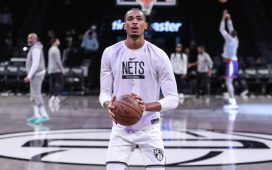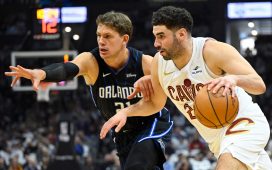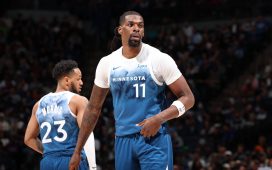Want more basketball in your inbox? Sign up for Marc Stein’s weekly N.B.A. newsletter here.
Sabrina Ionescu could spend a considerable amount of time, if she wished, dwelling on everything that was snatched away from her in what was scripted to be a momentous year.
She prefers to focus on the fortune that enabled her to avoid surgery after a nasty ankle injury prematurely ended her rookie season with the W.N.B.A.’s Liberty.
“With everything that’s happened, with everything that’s been out of my control, I’ve just handled it the best that I can,” Ionescu said.
Last fall, Ionescu, 22, returned to the University of Oregon for her senior season, rather than turn professional, to try to win the N.C.A.A. title that had eluded the Ducks in the 2018-19 season. When the coronavirus pandemic wiped out the 2020 N.C.A.A. women’s basketball tournament in March, Ionescu moved on to the W.N.B.A.
She was the No. 1 over all pick in the draft in April and one of the most celebrated rookies in league history — only to sustain a season-ending injury in the second quarter of her third pro game. Ionescu rolled her ankle when she stepped on the foot of the Atlanta Dream’s backpedaling Betnijah Laney. The Liberty, who had six other rookies besides Ionescu, sank to the league’s worst record (2-20) without her.
The injury, Ionescu said, was “definitely” the most severe of her career. It added another layer of struggle to a year that began with deep sorrow, after her friend and mentor Kobe Bryant and Bryant’s 13-year-old daughter, Gianna — whom Ionescu mentored — were among nine people killed in a Jan. 26 helicopter crash.
Ionescu spoke to The New York Times about the numerous challenges she has faced in 2020, spending time with Bryant’s family and life in the W.N.B.A. bubble at IMG Academy in Bradenton, Fla.
(This interview has been condensed and lightly edited for clarity.)
How are things going on the rehabilitation front?
I feel really good. Everything’s been going well, progressing as it should. It’s just been fun and exciting to get back out there and start playing and practicing.
How did you deal with the shock of having an injury so soon in your pro career?
It happens. It really wasn’t the end of the world. It wasn’t like my senior year of college or anything. I’ll have many, many more opportunities to play in the league, so it really wasn’t like a devastating experience. I kind of just took it for what it was and moved on.
The game before, to go for 33 points against the Dallas Wings, what did that feel like to be able to perform at that level so quickly?
I just felt comfortable. I obviously learned from the first game [Ionescu shot 4 for 17 from the field in her debut against the Seattle Storm] and just kept watching film and was just able to find my shots and felt more and more comfortable.
You faced big expectations throughout your college career, but how much different do pro expectations feel — being drafted to turn around a struggling franchise?
They don’t feel any different at all. The expectations I have for myself are always higher than anyone else’s, regardless of what level I’m playing at. It didn’t really matter that I was a rookie or it was my first year. I still had that same high level of expectation.
What was life like for you in the W.N.B.A. bubble?
It’s really hard, and it’s definitely not ideal. I think they did a great job keeping it safe and doing the best that they can with the short notice of having to kind of start the season and try to keep our best interests at hand. But, obviously, to eat, sleep and breathe your job is not always the best route that you could possibly take.
It definitely wasn’t easy being away from family and that support system, especially in my first year, and then obviously getting injured and kind of being stuck in that bubble and not being able to readily see who I need to see right away. But I think they did a great job just being able to keep us safe. Hopefully, if there’s a situation like this next year, we can just learn from it.
If next season is closer to typical, after spending your whole life on the West Coast, what do you imagine living and playing in New York will be like?
Hopefully really fun. I’m not nervous to get out there. I’m really excited to get out to Barclays and to be able to play with fans in an arena. Hopefully that happens, and we can get back to a little bit of the normal way of playing sports.
We’ve seen a few videos and pictures of you spending time with Kobe Bryant’s family. How helpful is it, if that’s even the right word, to grieve with them?
I think it’s helped all of us, just to be able to see each other, be around each other, tell stories, obviously be there for the good and the bad times, whatever it is. I’ll always be close to his family, and I think they know that they’ll always be close to me. So it’s been great to be able to just spend time with them, and that’s honestly been a blessing that I’ve been able to have that opportunity to be down in L.A. and see them.
To be asked to speak at Kobe’s memorial service — I honestly can’t even imagine taking that on.
It was difficult, but it was also an honor. Obviously being around such great people that were in attendance, some great teammates, all of his mentors, really everyone that was there — it was something that I am so happy that I was able to do and was asked to do.
At this point of your rehab, how much are you able to do?
I’m able to do just about everything that I want. I’m not playing live now and probably won’t be for a while, just because there’s no point playing live. It’s not necessarily for my health or my ankle, but just due to Covid-19 and everything going on. I don’t really feel like I want to go to a gym and start playing with random people at this point.
How hard is it for someone as competitive as you to be patient?
I’m actually pretty patient. I’m just making sure I’m staying healthy. There’s nothing really I’m rushing back for, so I think that’s definitely helped me. There’s not a game in a week that I need to get ready for. I have a while until next season, so I think this is going to be a time to just get my body where I want it to be.
The Scoop @TheSteinLine
This newsletter is OUR newsletter. So please weigh in with what you’d like to see here. To get your hoops-loving friends and family involved, please forward this email to them so they can jump in the conversation. If you’re not a subscriber, you can sign up here.
Corner Three
You ask; I answer. Every week in this space, I’ll field three questions posed via email at marcstein-newsletter@nytimes.com. Please include your first and last name, as well as the city you’re writing from, and make sure “Corner Three” is in the subject line.
(Responses may be condensed and lightly edited for clarity.)
Q: Any compelling reason M.V.P. voting shouldn’t include the playoffs, other than hidebound tradition? — @DavidJManson from Twitter
Stein: You presumably won’t like this answer, but I’m firmly in the camp that believes that the N.B.A.’s Most Valuable Player Award system is just fine the way it is.
The award Giannis Antetokounmpo won on Friday for the second consecutive season is a regular-season award. The N.B.A., remember, is forever searching for ways to add meaning to its 82-game regular season, so suggesting changes that potentially diminish the regular season further is a nonstarter. The case can be made that with the whole league forced to a neutral site to finish the season because of the coronavirus pandemic — wiping out home-court advantage and devaluing playoff seeding — there was no bigger prize from the 2019-20 regular season than the trophy Antetokounmpo just won.
I am no longer a year-end awards voter because The New York Times does not participate in such voting, but Giannis would have certainly been my pick after he produced the most efficient season in N.B.A. history (according to Stathead) while leading Milwaukee to the league’s best record. He also did all that without a sidekick of Anthony Davis’s caliber.
I know there have been calls for the players, rather than members of the news media, to vote — good luck with that. Have you seen some of the dubious selections players make when they vote for the All-Star Game? Denver’s Will Barton, to name one example, received more All-Star votes from players this season than Oklahoma City’s Chris Paul. Media members are hardly infallible, but they do generally take their voting responsibilities much more seriously.
There have also been calls for a third trophy to be awarded every season to the individual deemed “best player.” The thinking there is that neither the regular-season M.V.P. Award, which typically goes to the player deemed to have the strongest 82-game résumé, nor the N.B.A. finals M.V.P., awarded for postseason brilliance, is guaranteed to identify the game’s most outstanding individual force. My counter to that has always been: Why do we need a “best in the world” trophy?
Michael Jordan held that status for the bulk of his career — everyone knew he was the best, and that was a trophy in itself. The annual M.V.P. race allows us to have a meaningful (and theoretically enjoyable) debate about who had the best season. If the exercise was intended to identify who would be the No. 1 pick in an N.B.A. pickup game, we could do that before opening night pretty much every season.
Lots of things need fixing these days, in basketball and throughout the world, but this isn’t one of them. Not when Antetokounmpo, no matter how disappointing the Bucks were in the playoffs, had a historically dominant regular season.
Q: You made an error in the Sept. 8 newsletter. Scott Perry is a Black general manager with the Knicks. As with all the other executives you list, Perry’s decision-making power may be in question, but his exclusion from the list is a mistake. — Bobby Elliott
Stein: The list you’re referring to featured the seven executives (at the time) who held varying degrees of lead decision-making power in their front offices. There was no mistake; you omitted the word “lead.”
Perry is not the Knicks’ lead decision maker. He wasn’t when he was working alongside Steve Mills and he’s not now with Leon Rose in charge. The seven we listed all had different titles, but they all ranked as the top personnel voice with their teams: Cleveland’s Koby Altman, Detroit’s Troy Weaver, Philadelphia’s Elton Brand, Phoenix’s James Jones, Sacramento’s Joe Dumars, San Antonio’s Brian Wright and Toronto’s Masai Ujiri.
That group has since been reduced to six, however, with Sacramento hiring Houston’s Monte McNair to take over the Kings’ front office and reassigning Dumars from interim executive vice president for basketball operations to chief strategy officer.
Q: I read with interest your recent piece on Steve Nash. I see a lot in common with Juventus’s hiring of Andrea Pirlo as manager. Like Nash, Pirlo is a legendary former player (and playmaker) who will be immediately expected to deliver results despite his lack of coaching experience. Don’t forget, as a bonus, that the Nets not too long ago held a Juventus Night to cross-promote the two teams and also share a black-and-white color scheme with Juventus. Your thoughts? — Alberto Rondina (Fano, Italy)
Stein: It is apparently known, even in faraway Fano, how much I love questions that connect international soccer and the N.B.A. Thanks for this one, Alberto.
There are certainly some parallels between Pirlo’s situation and Nash’s — most notably the high-quality rosters both have inherited in their first jobs. This, of course, stems from the uncommon level both reached as players and on-field leaders. What they achieved as the equivalent of quarterbacks in their sports fast-tracked Pirlo and Nash to land desirable jobs despite lacking coaching experience.
But I see just as many differences as similarities. Pirlo spent all of last season obtaining the requisite coaching license needed to work at the top level in Italy. He had committed to coach Juventus’s under-23 team days before Juventus installed him as coach of the senior team. Pirlo was clearly on a coaching path.
The Nash news was much more of a curveball. It was widely assumed in league circles that he didn’t even want to work as a full-time assistant coach with an N.B.A. team, let alone accept the challenge of ushering Kevin Durant, Kyrie Irving and the rest of the Nets to title contention. Before my Sept. 3 tweet that he had been hired as the Nets’ new coach, Nash’s name hadn’t been publicly mentioned in connection with the Brooklyn job or any other.
So we’ll score the Nash appointment as the far bigger surprise, while conceding that Pirlo is under even more pressure than Nash in Year 1. Nothing less than a league title and a deep run in the Champions League will be expected from Juventus and its rookie manager because the Italian soccer media make New York’s ballyhooed press corps seem welcoming. I expect Nash to get the longer grace period, especially with Durant and Irving both likely returning from lengthy injury absences.
Numbers Game
12
The Celtics have played 12 consecutive games in these playoffs without the home team winning any of them. The streak included the last two games of Boston’s first-round sweep of Philadelphia, every game of the Celtics’ seven-round epic with Toronto in the second round and the first three games of the Eastern Conference finals against Miami. As my colleague Tom Haberstroh of NBC Sports noted last week, Boston’s second-round matchup with Toronto was the first in more than 600 best-of-seven series in N.B.A. playoff history in which the home team failed to win a single game.
5-19
In the four second-round playoff series, “home” teams were 5-19. Home teams have combined to finish above .500 in every postseason since the N.B.A. instituted a 16-team playoff format for the 1983-84 season. I seem to get pushback every time I bring this subject up on Twitter, but it is a statistic we can’t lose sight of because these playoffs — at a neutral site and with zero travel — are unlike any other in league history. The conditions are the same for every team, true, but this will be justifiably recorded by some historians (me included) as a different postseason than we’ve ever seen.
9
There have been nine comebacks from a 3-1 series deficit since the N.B.A. moved to the 16-team playoff format. Five of the nine have happened in the past five years, starting with Houston’s comeback against the Doc Rivers-coached Los Angeles Clippers in 2015. There were two such comebacks in 2016 (Golden State over Oklahoma City in the Western Conference finals and Cleveland over Golden State in the N.B.A. finals), and Denver delivered two in the first two rounds of these playoffs.
8
The Nuggets’ second-round resurrection against the Clippers inflicted the eighth Game 7 defeat of Rivers’s coaching career.
0
The array of first-round picks Kentucky Coach John Calipari has sent to the N.B.A. — 29 in 11 seasons with the Wildcats entering the Nov. 18 draft — has earned zero N.B.A. titles. But that drought could end this season with Denver’s Jamal Murray, Miami’s Bam Adebayo and Tyler Herro and the Los Angeles Lakers’ Anthony Davis still in contention for the 2020 title. (Boston’s Enes Kanter signed for Kentucky but was not allowed to play for Calipari because of N.C.A.A. eligibility issues.)
Hit me up anytime on Twitter (@TheSteinLine) or Facebook (@MarcSteinNBA) or Instagram (@thesteinline). Send any other feedback to marcstein-newsletter@nytimes.com.








